

 中文摘要:
中文摘要:
电阻率成像测井图像具有分辨率高、直观和可定量化的优势,在沉积储层研究上得到了广泛应用。研究以成像测井资料为主,结合大量的岩心、薄片和常规测井曲线的分析,将研究区鹰山组岩溶体系划分为11种成像测井相,包括溶蚀作用形成的溶洞相与构造作用形成的裂缝相构成的储层相类型、沉积作用形成的高阻隔层相类型,以及多种储集空间叠合的复合相类型等。在精细刻画岩溶体系的成像测井特征之后,认为塔中北斜坡鹰山组古岩溶体系中,形成有效储集层段的并非伽马高值的溶洞相,而是溶洞相之下、高阻隔层相之上的裂缝与溶孔的复合相,溶孔构成了油气的储集空间,而裂缝成为沟通储集空间的通道。多井分析结果表明,研究区受不整合面发育和构造古地貌等多重因素控制,古岩溶作用发育的鹰一段和鹰二段,显示出不同的岩溶特征。其中,鹰一段发育2套可识别的大型溶洞体系,而鹰二段则以小型溶洞、溶孔等均匀溶蚀作用为主。
 英文摘要:
英文摘要:
FMI (Formation Micro-Scanner Image) is widely used to analyze reservoir properties with the ad- vantages of high resolution,visible and quantified. In this study, 11 FMI facies are classified based on the combination of borehole images, cores, thin sections and open-hole logs. It includes reservoir types like carves and tectonic fractures, sedimentary interlayer types like high resistivity facies and two compound fa- cies of fractures and holes. Besides description of karst systems in borehole images,anomalies in GR curve attracting the researchers are analyzed by FMI images. It shows that compound facies of fractures and holes could be effective reservoir instead of caves with high GR value because oil/gas-bearing holes are connected by fractures. Two suites of karst system were formed in the OY1 while small scale caves and holes were formed in the OY2 because of lithological and structure locations. The results of this study demonstrated that,uncomformity and tectonic geomorphology control the differences of the paleokarst system.
 同期刊论文项目
同期刊论文项目
 同项目期刊论文
同项目期刊论文
 期刊信息
期刊信息
